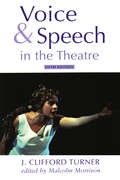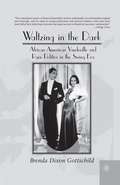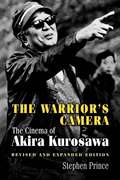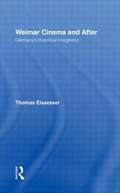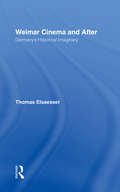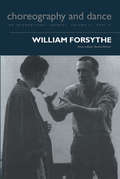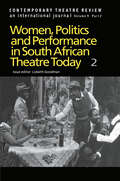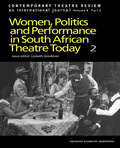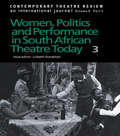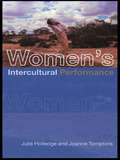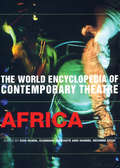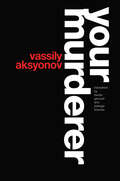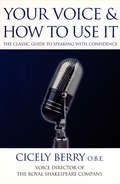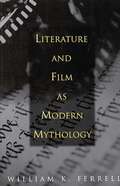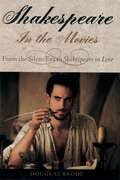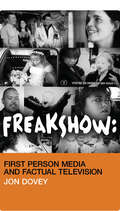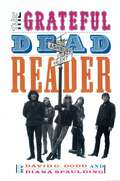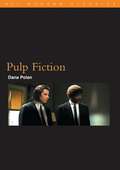- Table View
- List View
Voice and Speech in the Theatre
by J. Clifford Turner Malcolm MorrisonThis is a classic book on voice and speech, designed for actors at all levels. One of the great voice teachers of his day, J. Clifford Turner here uses simple and direct language to impart the necessary technical 'basics' of speech and voice.
Waltzing in the Dark: African American Vaudeville and Race Politics in the Swing Era
by NA NA Brenda Dixon GottschildThe career of Norton and Margot, a ballroom dance team whose work was thwarted by the racial tenets of the era, serves as the barometer of the times and acts as the tour guide on this excursion through the worlds of African American vaudeville, black and white America during the swing era, the European touring circuit, and pre-Civil Rights era racial etiquette.
The Warrior's Camera: The Cinema of Akira Kurosawa
by Stephen PrinceThe Japanese film director Akira Kurosawa, who died at the age of 88, has been internationally acclaimed as a giant of world cinema. Rashomon, which won both the Venice Film Festival's grand prize and an Academy Award for best foreign-language film, helped ignite Western interest in the Japanese cinema. Seven Samurai and Yojimbo remain enormously popular both in Japan and abroad. In this newly revised and expanded edition of his study of Kurosawa's films, Stephen Prince provides two new chapters that examine Kurosawa's remaining films, placing him in the context of cinema history. Prince also discusses how Kurosawa furnished a template for some well-known Hollywood directors, including Martin Scorsese, Steven Spielberg, and George Lucas. Providing a new and comprehensive look at this master filmmaker, The Warrior's Camera probes the complex visual structure of Kurosawa's work. The book shows how Kurosawa attempted to symbolize on film a course of national development for post-war Japan, and it traces the ways that he tied his social visions to a dynamic system of visual and narrative forms. The author analyzes Kurosawa's entire career and places the films in context by drawing on the director's autobiography--a fascinating work that presents Kurosawa as a Kurosawa character and the story of his life as the kind of spiritual odyssey witnessed so often in his films. After examining the development of Kurosawa's visual style in his early work, The Warrior's Camera explains how he used this style in subsequent films to forge a politically committed model of filmmaking. It then demonstrates how the collapse of Kurosawa's efforts to participate as a filmmaker in the tasks of social reconstruction led to the very different cinematic style evident in his most recent films, works of pessimism that view the world as resistant to change.
Weimar Cinema and After: Germany's Historical Imaginary
by Thomas ElsaesserGerman cinema of the 1920s is still regarded as one of the 'golden ages' of world cinema. Films such as The Cabinet of Dr Caligari, Dr Mabuse the Gambler, Nosferatu, Metropolis, Pandora's Box and The Blue Angel have long been canonised as classics, but they are also among the key films defining an image of Germany as a nation uneasy with itself. The work of directors like Fritz Lang, F.W. Murnau and G.W. Pabst, which having apparently announced the horrors of fascism, while testifying to the traumas of a defeated nation, still casts a long shadow over cinema in Germany, leaving film history and political history permanently intertwined. Weimar Cinema and After offers a fresh perspective on this most 'national' of national cinemas, re-evaluating the arguments which view genres and movements such as 'films of the fantastic', 'Nazi Cinema', 'film noir' and 'New German Cinema' as typically German contributions to twentieth century visual culture. Thomas Elsaesser questions conventional readings which link these genres to romanticism and expressionism, and offers new approaches to analysing the function of national cinema in an advanced 'culture industry' and in a Germany constantly reinventing itself both geographically and politically. Elsaesser argues that German cinema's significance lies less in its ability to promote democracy or predict fascism than in its contribution to the creation of a community sharing a 'historical imaginary' rather than a 'national identity'. In this respect, he argues, German cinema anticipated some of the problems facing contemporary nations in reconstituting their identities by means of media images, memory, and invented traditions.
Weimar Cinema and After: Germany's Historical Imaginary (PDF)
by Thomas ElsaesserGerman cinema of the 1920s is still regarded as one of the 'golden ages' of world cinema. Films such as The Cabinet of Dr Caligari, Dr Mabuse the Gambler, Nosferatu, Metropolis, Pandora's Box and The Blue Angel have long been canonised as classics, but they are also among the key films defining an image of Germany as a nation uneasy with itself. The work of directors like Fritz Lang, F.W. Murnau and G.W. Pabst, which having apparently announced the horrors of fascism, while testifying to the traumas of a defeated nation, still casts a long shadow over cinema in Germany, leaving film history and political history permanently intertwined. Weimar Cinema and After offers a fresh perspective on this most 'national' of national cinemas, re-evaluating the arguments which view genres and movements such as 'films of the fantastic', 'Nazi Cinema', 'film noir' and 'New German Cinema' as typically German contributions to twentieth century visual culture. Thomas Elsaesser questions conventional readings which link these genres to romanticism and expressionism, and offers new approaches to analysing the function of national cinema in an advanced 'culture industry' and in a Germany constantly reinventing itself both geographically and politically. Elsaesser argues that German cinema's significance lies less in its ability to promote democracy or predict fascism than in its contribution to the creation of a community sharing a 'historical imaginary' rather than a 'national identity'. In this respect, he argues, German cinema anticipated some of the problems facing contemporary nations in reconstituting their identities by means of media images, memory, and invented traditions.
Weimar Cinema and After: Germany's Historical Imaginary
by Thomas ElsaesserGerman cinema of the 1920s is still regarded as one of the 'golden ages' of world cinema. Films such as The Cabinet of Dr Caligari, Dr Mabuse the Gambler, Nosferatu, Metropolis, Pandora's Box and The Blue Angel have long been canonised as classics, but they are also among the key films defining an image of Germany as a nation uneasy with itself. The work of directors like Fritz Lang, F.W. Murnau and G.W. Pabst, which having apparently announced the horrors of fascism, while testifying to the traumas of a defeated nation, still casts a long shadow over cinema in Germany, leaving film history and political history permanently intertwined.Weimar Cinema and After offers a fresh perspective on this most 'national' of national cinemas, re-evaluating the arguments which view genres and movements such as 'films of the fantastic', 'Nazi Cinema', 'film noir' and 'New German Cinema' as typically German contributions to twentieth century visual culture. Thomas Elsaesser questions conventional readings which link these genres to romanticism and expressionism, and offers new approaches to analysing the function of national cinema in an advanced 'culture industry' and in a Germany constantly reinventing itself both geographically and politically.Elsaesser argues that German cinema's significance lies less in its ability to promote democracy or predict fascism than in its contribution to the creation of a community sharing a 'historical imaginary' rather than a 'national identity'. In this respect, he argues, German cinema anticipated some of the problems facing contemporary nations in reconstituting their identities by means of media images, memory, and invented traditions.
Weimar Cinema and After: Germany's Historical Imaginary
by Thomas ElsaesserGerman cinema of the 1920s is still regarded as one of the 'golden ages' of world cinema. Films such as The Cabinet of Dr Caligari, Dr Mabuse the Gambler, Nosferatu, Metropolis, Pandora's Box and The Blue Angel have long been canonised as classics, but they are also among the key films defining an image of Germany as a nation uneasy with itself. The work of directors like Fritz Lang, F.W. Murnau and G.W. Pabst, which having apparently announced the horrors of fascism, while testifying to the traumas of a defeated nation, still casts a long shadow over cinema in Germany, leaving film history and political history permanently intertwined.Weimar Cinema and After offers a fresh perspective on this most 'national' of national cinemas, re-evaluating the arguments which view genres and movements such as 'films of the fantastic', 'Nazi Cinema', 'film noir' and 'New German Cinema' as typically German contributions to twentieth century visual culture. Thomas Elsaesser questions conventional readings which link these genres to romanticism and expressionism, and offers new approaches to analysing the function of national cinema in an advanced 'culture industry' and in a Germany constantly reinventing itself both geographically and politically.Elsaesser argues that German cinema's significance lies less in its ability to promote democracy or predict fascism than in its contribution to the creation of a community sharing a 'historical imaginary' rather than a 'national identity'. In this respect, he argues, German cinema anticipated some of the problems facing contemporary nations in reconstituting their identities by means of media images, memory, and invented traditions.
William Forsythe
by Senta DriverFirst Published in 2000. Routledge is an imprint of Taylor & Francis, an informa company.
William Forsythe: A Tool For The Analytical Dance Eye
by Senta DriverFirst Published in 2000. Routledge is an imprint of Taylor & Francis, an informa company.
Women, Politics and Performance in South African Theatre Today: Volume 2
by Goodman LFirst Published in 1999. Routledge is an imprint of Taylor & Francis, an informa company.
Women, Politics and Performance in South African Theatre Today: Volume 2
by Goodman LFirst Published in 1999. Routledge is an imprint of Taylor & Francis, an informa company.
Women, Politics and Performance in South African Theatre Today Vol 3 (Contemporary Theatre Review Ser. #Vols. 9, Pts. 3.)
by Lizbeth GoodmanThis title available in eBook format. Click here for more information.Visit our eBookstore at: www.ebookstore.tandf.co.uk.
Women, Politics and Performance in South African Theatre Today Vol 3
by Lizbeth GoodmanThis title available in eBook format. Click here for more information.Visit our eBookstore at: www.ebookstore.tandf.co.uk.
Women's Intercultural Performance
by Julie Holledge Joanne TompkinsThis is the first in-depth examination of contemporary intercultural performance by women around the world. Contemporary feminist performance is explored in the contexts of current intercultural practices, theories and debates. Holledge and Tompkins provide ways of thinking about and analysing contemporary performance and representations of the performing, female, culturally-marked body. The book includes discussions of: * ritual performance by women from Central Australia and Korea * the cultural exchange of A Doll's House and Antigone * plays from Algeria, South Africa and Ghana * the work of the Takarazuka revue company * the market forces that govern the distribution of women and women's performance. This is an essential read for anyone studying or interested in women's performance.
Women's Intercultural Performance
by Julie Holledge Joanne TompkinsThis is the first in-depth examination of contemporary intercultural performance by women around the world. Contemporary feminist performance is explored in the contexts of current intercultural practices, theories and debates. Holledge and Tompkins provide ways of thinking about and analysing contemporary performance and representations of the performing, female, culturally-marked body. The book includes discussions of: * ritual performance by women from Central Australia and Korea * the cultural exchange of A Doll's House and Antigone * plays from Algeria, South Africa and Ghana * the work of the Takarazuka revue company * the market forces that govern the distribution of women and women's performance. This is an essential read for anyone studying or interested in women's performance.
World Encyclopedia of Contemporary Theatre: Africa (World Encyclopedia Of Contemporary Theatre Ser.)
by Don Rubin Ousmane Diakhaté Hansel Ndumbe EyohNow available in paperback for the first time this edition of the World Encyclopedia of Contemporary Theatre series examines theatrical developments in Africa since 1945. Entries on thirty-two African countries are featured in this volume, preceded by specialist introductory essays on Anglophone Africa, Francophone Africa, History and Culture, Cosmology, Music, Dance, Theatre for Young Audiences and Puppetry. There are also special introductory general essays on African theatre written by Nobel Prize Laureate Wole Soyinka and the outstanding Congolese playwright, Sony Labou Tansi, before his untimely death in 1995. More up-to-date and more wide-ranging than any other publication, this is undoubtedly a major ground-breaking survey of contemporary African theatre.
World Encyclopedia of Contemporary Theatre: Africa
by Ousmane Diakhate Hansel Ndumbe Eyoh Don RubinNow available in paperback for the first time this edition of the World Encyclopedia of Contemporary Theatre series examines theatrical developments in Africa since 1945. Entries on thirty-two African countries are featured in this volume, preceded by specialist introductory essays on Anglophone Africa, Francophone Africa, History and Culture, Cosmology, Music, Dance, Theatre for Young Audiences and Puppetry. There are also special introductory general essays on African theatre written by Nobel Prize Laureate Wole Soyinka and the outstanding Congolese playwright, Sony Labou Tansi, before his untimely death in 1995. More up-to-date and more wide-ranging than any other publication, this is undoubtedly a major ground-breaking survey of contemporary African theatre.
Your Murderer
by Vassily AksyonovFrom Russia comes this ironic, satirical, multi-layered, modern pop-art parable by Vassily Aksyonov. Your Murderer is a richly grotesque hodgepodge of different linguistic levels that defies all rules and mixes a powerful cocktail out of traditional slogans, invented obscentities, foreign words and phrases, terminology from sports and heavy drinking, and pure nonsense. Daniel Gerould is Lucille Lortel Distinguished Professor of Theater and Comparative Literature at the City University of New York. He is the Editor of Slavic and East European Performance and of harwood academic publishers's Polish and East European Theater Archive series. Your Murderer comes from Russia and is an ironic, satirical, multi-layered, modern pop-art parable - richly grotesque and on different linguistic levels. that defies all rules, mixing a powerful cocktail out of traditional slogans, invented obscentities, foreign words and phrases, terminology from sports and heavy drinking, and pure nonsense.
Your Murderer (Russian Theatre Archive Ser. #Vol. 18.)
by Vassily AksyonovFrom Russia comes this ironic, satirical, multi-layered, modern pop-art parable by Vassily Aksyonov. Your Murderer is a richly grotesque hodgepodge of different linguistic levels that defies all rules and mixes a powerful cocktail out of traditional slogans, invented obscentities, foreign words and phrases, terminology from sports and heavy drinking, and pure nonsense. Daniel Gerould is Lucille Lortel Distinguished Professor of Theater and Comparative Literature at the City University of New York. He is the Editor of Slavic and East European Performance and of harwood academic publishers's Polish and East European Theater Archive series. Your Murderer comes from Russia and is an ironic, satirical, multi-layered, modern pop-art parable - richly grotesque and on different linguistic levels. that defies all rules, mixing a powerful cocktail out of traditional slogans, invented obscentities, foreign words and phrases, terminology from sports and heavy drinking, and pure nonsense.
Your Voice and How to Use it: The Classical Guide To Speaking With Confidence
by Cicely BerryAnxiety about how we speak prevents many of us from expressing ourselves well. In her classic handbook, Cicely Berry, Voice Director of the Royal Shakespeare Company and world-famous voice teacher, tackles the reasons for this anxiety and explains her practical exercises for relaxation and breathing, clarity of diction and vocal flexibility - everything that you need to achieve good speech.
Literature and Film as Modern Mythology
by William K. FerrellNovels and films record and codify the cultural experiences of their people. This book explores the relationship between contemporary literature and film of the past fifty years and the ancient myths of Judeo-Christian, Greek, Celtic, and Eastern origin. Following a detailed description and explanation of both literary and film devices, stories that inform to a mythic tradition are analyzed to identify what they reveal about modern culture. This work explores such diverse subjects as heroism, coming of age, and morality. This approach to literature and film explores how contemporary fiction and film fulfill a continuum in our never-ending search to understand how life ought to be lived.Encompassing a broad spectrum of modern film and fiction, a variety of authors and directors are represented. Included are novels from such writers as Stephen King, Alice Walker, Ken Kesey, Jerzy Kosinski, Robert Penn Warren, and Michael Ondaatje. Film directors include Stephen Spielberg, Hal Ashby, Phil Alden Robinson, George Stevens, Robert Rossen, and Milos Forman. As a valuable resource for film and literature classes alike, this work also provides suggestions for student projects.
Shakespeare in the Movies: From the Silent Era to Shakespeare in Love
by Douglas BrodeShakespeare is now enjoying perhaps his most glorious--certainly his most popular--filmic incarnation. Indeed, the Bard has been splashed across the big screen to great effect in recent adaptations of Hamlet, Henry V, Othello, Twelfth Night, Romeo and Juliet, Much Ado About Nothing, Richard II, A Midsummer Night's Dream, and of course in the hugely successful Shakespeare in Love. Unlike previous studies of Shakespeare's cinematic history, Shakespeare in the Movies proceeds chronologically, in the order that plays were written, allowing the reader to trace the development of Shakespeare as an author--and an auteur--and to see how the changing cultural climate of the Elizabethans flowered into film centuries later. Prolific film writer Douglas Brode provides historical background, production details, contemporary critical reactions, and his own incisive analysis, covering everything from the acting of Marlon Brando, Laurence Olivier, Richard Burton, and Gwyneth Paltrow, to the direction of Orson Welles, Kenneth Branagh, and others. Brode also considers the many films which, though not strict adaptations, contain significant Shakespearean content, such as West Side Story and Kurosawa's Ran and Throne of Blood. Nor does Brode ignore the ignoble treatment the master has sometimes received. We learn, for instance, that the 1929 version of The Taming of the Shrew (which featured the eyebrow-raising writing credit: "By William Shakespeare, with additional dialogue by Sam Taylor"), opens not so trippingly on the tongue--PETRUCHIO: "Howdy Kate." KATE: "Katherine to you, mug." For anyone wishing to cast a backward glance over the poet's film career and to better understand his current big-screen popularity, Shakespeare in the Movies is a delightful and definitive guide.
Freakshow: First Person Media and Factual Television
by Jon DoveyTrue confessions, fake films and docu-soaps - in the last ten years factual television has been transformed by an explosion of new genres. Freakshow offers a serious look at 'reality TV' in an attempt to understand the mass media’s fascination with intimacy, deviancy, and horror. *BR**BR*Jon Dovey analyses reality TV in terms of the political economy of the mass media. He investigates the relationship between confessional television and our modern understanding of culture and identity. Is our fascination with the personal the only meaningful response to the complexity of our own lives? Are the politics of the self the only alternative to the defunct grand narratives of yesterday? *BR**BR*In concentrating not on the reception of these new television forms but on the choices, models and agendas which inform their production, Dovey reveals the relationships between social anxieties, economic pressures and their specific inflections in media texts. In a critical analysis of media industry practice, Dovey asks why directors can't stay out of range of their own cameras - and what is the role of the television of intimacy within broadcasting.
The Grateful Dead Reader (Readers on American Musicians)
Arranged in chronological order, these pieces add up to nothing less than a full-scale history of the greatest tour band in the history of rock. From Tom Wolfe's account of the Dead's first performance as the Grateful Dead (at an Acid Test in 1965), to Ralph Gleason's 1967 interview with the 24-year-old Jerry Garcia, to Mary Eisenhart's obituary of the beloved leader of the band, these selections include not only outstanding writing on the band itself, but also superb pieces on music and pop culture generally. Fans will be fascinated by the poetry, fiction, drawings, and rare and revealing photographs featured in the book, as well as the anthology's many interviews and profiles, interpretations of lyrics, and concert and record reviews. Still, The Grateful Dead was more than a band--it was a cultural phenomenon. For three decades it remained on one unending tour, followed everywhere by a small army of nomadic fans. This phenomenon is both analyzed and celebrated here, in such pieces as Ed McClanahan's groundbreaking article in Playboy in 1972, fan-magazine editor Blair Jackson's 1990 essay on the seriousness of the drug situation at Dead concerts, and Steve Silberman's insightful essays on the music and its fans.
Pulp Fiction (BFI Film Classics)
by Dana PolanDana Polan sets out to unlock the style and technique of 'Pulp Fiction'. He shows how broad Tarantino's points of reference are, and analyzes the narrative accomplishment and complexity. In addition, Polan argues that macho attitudes celebrated in film are much more complex than they seem.
